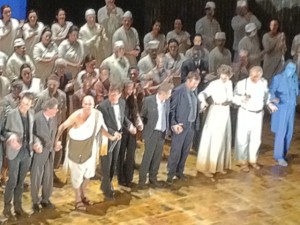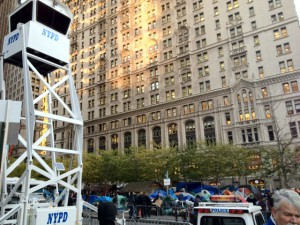 Let me change direction for a moment and consider this in 2 events of this past Friday.
Let me change direction for a moment and consider this in 2 events of this past Friday.
Friday night I had the honor of being able to attend this season’s Metropolitan Opera premiere of Satyagraha, the Philip Glass opera about the life of Gandhi (or part of it at least, including elements in his earlier life in South Africa where he developed his worldview). With Glass’s style of repeating a few chords in ways that are soothing and hypnotic and energizing all at one, along with this dynamic production that used visuals and technology to tell the simple story in a way that brings it to life to a contemporary audience in a fresh way, I had a profound sense of how important Gandhi is as an historical figure and as an icon for standing up for one’s beliefs, supporting the freedom of action and self-government of an oppressed people. I saw this opera the last time it was at the MetOpera in 2008, and it affected me even stronger this time around. Perhaps I knew more about Glass’ intentions, his music, and the complicated production that tells a story without allowing us to refer to the libretto.
 Could Glass’s style add to social artistry, by offering a renewed sense of how historical action is just as relevant to our lives today? I kept thinking about Occupy Wall Street (OWS), something I have not been able to get my mind around (who ever heard of a protest without clear and simple demands?). Even when I was finally in the financial district in New York earlier on Friday, I snapped a few photos as a reminder, not knowing where or how this will develop. I did not initially make the connection between their work and Gandhi, though after seeing the opera later that night (yes, the irony between high art and its associated costs is not lost on me), I have since been thinking about the OWS protests that have spread around the world.
Could Glass’s style add to social artistry, by offering a renewed sense of how historical action is just as relevant to our lives today? I kept thinking about Occupy Wall Street (OWS), something I have not been able to get my mind around (who ever heard of a protest without clear and simple demands?). Even when I was finally in the financial district in New York earlier on Friday, I snapped a few photos as a reminder, not knowing where or how this will develop. I did not initially make the connection between their work and Gandhi, though after seeing the opera later that night (yes, the irony between high art and its associated costs is not lost on me), I have since been thinking about the OWS protests that have spread around the world.
None of this would have been possible without technology, and while the Met Opera’s production was planned long before OWS began, the connection between the two is uncanny. As a matter of fact, without hearing so much about OWS online for several weeks, I would not have even known it was happening. Leave it to corporate media outlets to not investigate its claims more fully, but that may be a sign of the protest itself and best left to more discussion at another time.
I wonder if that is also a role of a social artist, to bring an awareness of human experience and help others see connections that may easily be missed and then process them together to lead to action to improve elements of society? Could this be what Nancy White showed in the interactive slides and periods of silence she allowed and promoted in her 2 #change11 MOOC sessions this week?
Good to hear how much you enjoyed your evening with Philip Glass, Jeffrey. I did spend part of my weekend with his nephew, Ira 😉
You know, in many ways, I think that he could be considered a social artist because music, as noted by Nancy when Stephen gave us the lovely Canadian folk music during Friday’s session, can contribute to the creation of a space for “people to interact and learn with each other.”
And Gandhi? I’d count him as a type of social artist because he did, and even now years after his death, continues to create metaphorical spaces that encourage us to think about injustice and what we can do to overcome it. Coincidentally, I was in a session on Friday with author/editor Marc Aronson who told me and a few hundred middle schoolers and teachers about the Caribbean sugar plantation system and the Gandhi connection. There was an audible hush as Aronson described Gandhi as a young Indian lawyer who argues the case of a indentured worker beaten on the plantation. I’d venture that there are few historical figures that can give middle schoolers pause to reflect.
Thanks for the thoughtful question!
@Cris-
Thanks for your comment; your statement of a social artist as one who “creates space for people to interact and learn with one another” is quite helpful.
I wonder to what extent this has to be a conscious and intentional action?
Jeffrey